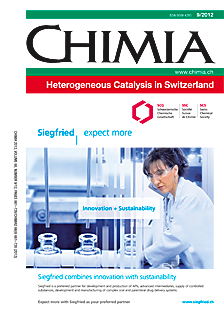Catalytic Conversion of Methane to Methanol Using Cu-Zeolites
DOI:
https://doi.org/10.2533/chimia.2012.668Keywords:
Cu-zeolites, Methane, Methanol, Partial oxidation, X-ray absorption spectroscopyAbstract
The conversion of methane to value-added liquid chemicals is a promising answer to the imminent demand for fuels and chemical synthesis materials in the advent of a dwindling petroleum supply. Current technology requires high energy input for the synthesis gas production, and is characterized by low overall selectivity, which calls for alternative reaction routes. The limitation to achieve high selectivity is the high C–H bond strength of methane. High-temperature reaction systems favor gas-phase radical reactions and total oxidation. This suggests that the catalysts for methane activation should be active at low temperatures. The enzymatic-inspired metal-exchanged zeolite systems apparently fulfill this need, however, methanol yield is low and a catalytic process cannot yet be established. Homogeneous and heterogeneous catalytic systems have been described which stabilize the intermediate formed after the first C–H activation. The understanding of the reaction mechanism and the determination of the active metal sites are important for formulating strategies for the upgrade of methane conversion catalytic technologies.Downloads
Published
2012-09-26
Issue
Section
Scientific Articles
License
Copyright (c) 2012 Swiss Chemical Society

This work is licensed under a Creative Commons Attribution-NonCommercial 4.0 International License.
How to Cite
[1]
Chimia 2012, 66, 668, DOI: 10.2533/chimia.2012.668.







